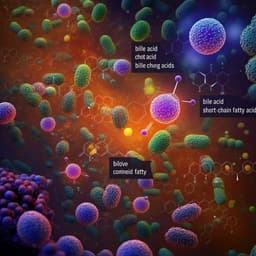
Medicine and Health
Social and psychological adversity are associated with distinct mother and infant gut microbiome variations
B. B. Warner, B. A. Rosa, et al.
This groundbreaking research by Barbara B. Warner and colleagues reveals how prenatal social disadvantage and psychosocial stressors can dramatically shape the gut microbiome in mothers and their children. With far-reaching implications for health equity, these findings highlight potential targets for interventions to improve outcomes for vulnerable populations.
~3 min • Beginner • English
Introduction
Health inequities linked to social disadvantage (SD) and psychosocial stressors (PS) often begin in the prenatal period and are associated with chronic systemic inflammation. The gut microbiome (GM) shapes immune development and inflammatory tone, and is itself influenced by environmental factors such as diet, housing, and stress. Prior work has associated lower socioeconomic status with reduced microbial diversity and has implicated the GM in inflammatory and autoimmune conditions more prevalent in disadvantaged populations. Yet, the biological embedding of SD and PS, particularly from prenatal exposure, and their distinct influences on maternal and infant GMs remain unclear. This study aims to disentangle the associations of maternal prenatal SD and PS with GM structure and function in mother-infant dyads and to explore links with maternal circulating cytokines, hypothesizing that SD and PS are associated with distinct microbial taxa and metabolic pathways in mothers and infants, and that infant GMs may reflect maternal inflammatory milieu.
Literature Review
The authors note few studies have examined the joint impact of socioeconomic and psychosocial factors on the human GM during the perinatal period. Existing studies often focused on either maternal psychological state or socioeconomic status, not both, frequently relied on 16S rRNA amplicon profiling limiting taxonomic and metabolic resolution, and rarely paired maternal and infant samples to study potential biologic transfer. Prior reports linked lower neighborhood SES with reduced diversity in adults, and maternal prenatal stress with infant microbiota alterations. Genera such as Bifidobacterium, Bacteroides, Faecalibacterium, Prevotella, and Blautia have been variably associated with health, inflammatory disorders, or major depressive disorder across studies. These gaps motivated a species- and pathway-level whole-metagenome investigation in mother-infant dyads, explicitly separating SD from PS effects and incorporating maternal cytokines.
Methodology
Design: Prospective case-control analysis nested within the Early Life Adversity and Biological Embedding (eLABE) cohort recruited 2017–2020 at Washington University in St. Louis. Inclusion for this analysis required term delivery (≥37 weeks) and availability of maternal third-trimester (T3) and infant 4-month stool samples. A total of 121 mother-infant dyads underwent 16S rRNA V4 profiling; a subset of 89 dyads, selected from extremes of SD or PS (≥ +0.5 SD or ≤ −0.5 SD from the mean), underwent whole-metagenome shotgun (WMS) sequencing.
Exposures: Two latent factors were computed: Maternal Social Disadvantage (SD: insurance status, income-to-needs ratio, education, Area Deprivation Index, Healthy Eating Index) and Psychosocial Stressors (PS: EPDS, Perceived Stress Scale averaged across trimesters, lifetime STRAIN, Everyday Discrimination). Maternal circulating cytokines (IL-6, IL-8, IL-10, TNFα) were measured in T3 serum.
Specimen collection and processing: Maternal serum and home-collected stools were processed and stored at −80°C. DNA extraction used QIAamp Power Fecal Pro with bead-beating and QIAcube automation.
16S profiling: Illumina MiSeq 2×250 bp of V4 region for 242 samples (121 mothers, 121 infants). QIIME2 with DADA2 denoising generated ASVs (3,072 ASVs detected). Taxonomy via SILVA v132. Rarefaction to 11,929 reads/sample. Alpha diversity (Faith’s phylogenetic diversity and Shannon) and beta diversity (weighted/unweighted UniFrac, Bray-Curtis, Aitchison) were computed. Dirichlet Multinomial Mixtures (DMM) clustering with NMDS visualization and cluster validation (lplc, silhouette, prediction strength) were applied.
WMS profiling: Illumina NovaSeq S4 2×150 bp, ~6 Gb/sample (89 mothers, 89 infants). Reads trimmed (Trimmomatic), human reads removed (BMTagger). Taxonomic profiling mapped to UHGG v1; 2,219 genomes detected overall (1,274 in ≥3 maternal or ≥3 infant samples). Functional profiling used HUMAnN3 with ChocoPhlAn and UniRef90 to quantify MetaCyc pathways; 468 pathways detected (438 in ≥3 maternal or ≥3 infant samples), CPM-normalized.
Statistical analyses: Associations between SD and PS assessed by Pearson correlation. Group differences in metadata via t-tests, Mann-Whitney U, or chi-square as appropriate (normality via Shapiro-Wilk). Diversity comparisons used correlation tests and two-sided Mann-Whitney U with Benjamini-Hochberg FDR correction for multiple beta-diversity tests. Supervised learning via Random Forest (randomForest R package) evaluated classification of high vs low SD/PS (and high vs low cytokines) using UHGG genome and MetaCyc pathway profiles; significance of accuracy via binomial tests with FDR correction; ROC AUCs via ROCR and Mann-Whitney U. Differential abundance corroboration by LEfSe (Kruskal-Wallis with FDR correction; LDA effect size thresholds: taxa ≥2, pathways ≥1) and ANCOM-BC2. Network analyses in Cytoscape linked discriminatory taxa to pathways. Breastfeeding frequency at 4 months was recorded and incorporated descriptively in diversity analyses.
Key Findings
Cohort and exposure correlation: Among 121 dyads, SD and PS were moderately correlated (r=0.395, df=119, P=7.2×10^-6).
Diversity patterns:
- Mothers: SD and PS trended negatively with alpha diversity but were not significant.
- Infants (4 months): Alpha diversity positively correlated with SD (r=0.579, P=3.6×10^-12) and PS (r=0.327, P=2.5×10^-4); high SD/PS infants were less breastfed, consistent with higher diversity seen in formula-fed infants.
- Mother–child similarity: Weighted UniFrac distances between mother–child pairs negatively correlated with SD (r=−0.438, P=5.0×10^-7) and PS (r=−0.295, P=1.0×10^-3), i.e., higher SD/PS associated with more similar mother–infant GMs.
- Clustering: DMM separated mothers from children overall. Within children, two clusters differed significantly by SD (FDR-adjusted P=2.7×10^-9) and PS (P=6.9×10^-3). Mothers’ clusters did not differ by SD/PS.
- Beta-diversity variance: High-SD mothers had more variable GMs than low-SD (FDR-corrected P=4.3×10^-5); PS effect stronger (P=2.3×10^-7). Among infants, high-SD had the most similar profiles; low- vs high-SD infant GMs were dissimilar relative to within-group similarities (both comparisons P<10^-15).
Taxonomic discriminators (WMS species-level):
- Mothers: Low-SD enriched for Firmicutes A including Lawsonibacter asaccharolyticus (top low-SD predictor; butyrate producer). High-SD enriched for Bifidobacterium spp. (B. catenulatum, B. bifidum, B. breve, B. infantis). Low-PS associated with Bacteroides A mediterraneensis, Faecalibacterium sp., and Prevotella sp001275135; high-PS associated with Blautia spp. and Eggerthella lenta.
- Children: High-SD enriched for Enterobacter nimipressuralis and Klebsiella pneumoniae (LPS-expressing Proteobacteria). Low-SD enriched for B. infantis (mean 28.3% of GM in low-SD vs 5.2% in high-SD; LEfSe P=0.01). Low-SD/low-PS also showed Veillonella parvula A and Collinsella spp.; high-PS enriched for Faecalicatena (Ruminococcus) gnavus and Sutterella sp.
Functional pathways (MetaCyc):
- Mothers: High-SD associated with carbohydrate metabolism pathways (e.g., sucrose degradation IV, glycogen degradation I, starch degradation III), largely contributed by B. bifidum and B. infantis; also UDP-N-acetyl-D-glucosamine biosynthesis I and L-threonine biosynthesis. High-PS associated with myo-, chiro-, scyllo-inositol degradation, potentially linking to inositol deficiency.
- Children: High-SD associated with L-glutamate and L-glutamine biosynthesis, L-glutamine biosynthesis III, and L-tryptophan biosynthesis; Klebsiella pneumoniae contributed substantially to pyrimidine deoxyribonucleotide biosynthesis from CTP and glycerol degradation to 1,3-propanediol.
Predictive performance (Random Forest on UHGG genomes):
- Mothers: SD classification accuracy 81.4% (P=2.5×10^-3); AUC=0.794 (P=2.0×10^-4). PS accuracy 68.8% (P=8.2×10^-4); AUC=0.735 (P=1.6×10^-4).
- Children: SD accuracy 90.7% (P=1.3×10^-7); AUC=0.868 (P=2.9×10^-9). PS accuracy 62.5% (P=4.9×10^-3); AUC=0.721 (P=2.1×10^-3).
- Pathway-based classification had lower accuracies (e.g., children SD 80.8%, P=5.2×10^-7), reflecting conserved core functions.
Maternal cytokines and infant microbiome:
- Only IL-8 correlated modestly with SD/PS overall (IL-8 vs SD/PS r=0.252, P=0.022). Infants’ metagenomes at 4 months significantly predicted high vs low maternal prenatal IL-6 (P=0.029; overall accuracy reported ~66.7%).
- Low maternal IL-6 associated infant taxa: Bifidobacterium bifidum, B. infantis, Collinsella sp. High maternal IL-6 associated: B. adolescentis, B. pseudocatenulatum, Enterobacter himalayensis; several Blautia spp. Pathways overlapping with SD/PS signals included inositol degradation, L-glutamine biosynthesis, and thiamine diphosphate salvage II.
Overall, SD had stronger and more distinct taxonomic/functional signatures than PS, with notable roles for Bifidobacterium species across comparisons and breastfeeding patterns influencing infant GM signatures.
Discussion
The study demonstrates that prenatal maternal social disadvantage and psychosocial stressors are associated with distinct gut microbiome configurations in both mothers and their 4-month-old infants. By separating SD from PS, the authors show these constructs relate to different microbial taxa and metabolic functions, supporting the idea of divergent biological pathways: SD signatures in mothers are enriched in carbohydrate-metabolizing Bifidobacterium species and associated pathways, while PS signatures include specific taxa such as Blautia and inositol degradation metabolism. In infants, SD associates with increased alpha diversity and a shift toward more adult-like and Proteobacteria-enriched communities with reduced B. infantis, patterns plausibly mediated by lower breastfeeding frequency among high-SD dyads. These findings align with known GM–immune interactions and suggest that early social environments may shape infant GM assembly during critical developmental windows, potentially influencing inflammatory tone and long-term health. The ability of infant metagenomes to predict maternal prenatal IL-6, and the overlap of IL-6-associated taxa/pathways with SD/PS-associated features, further implicates the GM as a conduit linking social adversity to inflammation. The identification of species-level and pathway-level markers offers mechanistic hypotheses and modifiable targets (e.g., breastfeeding support, microbiome-directed interventions) to mitigate health inequities.
Conclusion
This work provides species- and pathway-level evidence that maternal prenatal social disadvantage and psychosocial stressors are associated with distinct gut microbiome signatures in mothers and their infants, with stronger predictive signals for SD than PS. High-SD/high-PS mothers exhibited greater inter-individual GM variability, while infants’ GMs showed SD/PS-associated clustering and diversity patterns influenced by breastfeeding. Key discriminatory taxa included Lawsonibacter asaccharolyticus (low-SD mothers), multiple Bifidobacterium species (high-SD mothers; B. infantis enriched in low-SD infants), Blautia spp. (high-PS mothers), and proinflammatory Proteobacteria (high-SD infants). Functionally, carbohydrate degradation, glutamine/glutamate synthesis, tryptophan biosynthesis, and inositol degradation pathways were associated with adversity groups. Infant metagenomes modestly predicted maternal prenatal IL-6, with overlapping taxa/pathways seen in SD/PS analyses. These findings highlight potentially modifiable factors, including breastfeeding support and microbiome-targeted strategies, to reduce inequities. Future research should include longitudinal follow-up to assess persistence of GM signatures, causal testing in preclinical models, multi-site validation, and trials of targeted interventions and policy measures that support breastfeeding and early-life nutrition in disadvantaged populations.
Limitations
- Observational design; associations cannot establish causality.
- Single metropolitan region cohort; generalizability may be limited.
- English-speaking eligibility and requirement for third-trimester stool collection may bias toward higher SES participation.
- Oversampling of socially disadvantaged clinics to enable contrasts may introduce selection effects.
- Cytokine analyses had smaller sample sizes (approximately 45–55 per group), reducing power; IL-6 prediction accuracy modest.
- Race effects were not modeled separately due to collinearity with SD; potential confounding remains.
- Bioinformatic analyses were not blinded to metadata (blinding infeasible), and randomization of sequencing batches was not performed.
- Pathway-level classification had lower accuracy due to functional conservation across samples.
- A limited number of infants had antibiotic exposure before sampling (n=4), which could influence GM, though numbers were small.
Related Publications
Explore these studies to deepen your understanding of the subject.







